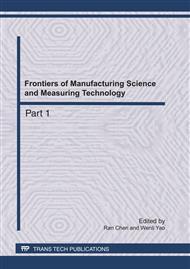p.1199
p.1204
p.1210
p.1216
p.1221
p.1226
p.1231
p.1236
p.1242
Simulation of High-Speed Cutting Process Based on ABAQUS
Abstract:
Using the separation line technology, established a FE model of two-dimensional cutting process for AISI4340 steel and discussed some basic theory and pivotal questions associated with the simulation of cutting process including the Johnson-Cook material model, the contact model between tool and chip, criteria of chip separation and so on. In order to study the impact of tool rake angle on the chip morphology and the cutting forces, the high-speed cutting process for AISI 4340 steel was simulated based on ABAQUS software. Also, analyzed the influence of mesh azimuth on the chip morphology and its temperature distribution.
Info:
Periodical:
Pages:
1221-1225
Citation:
Online since:
May 2011
Authors:
Price:
Сopyright:
© 2011 Trans Tech Publications Ltd. All Rights Reserved
Share:
Citation:


